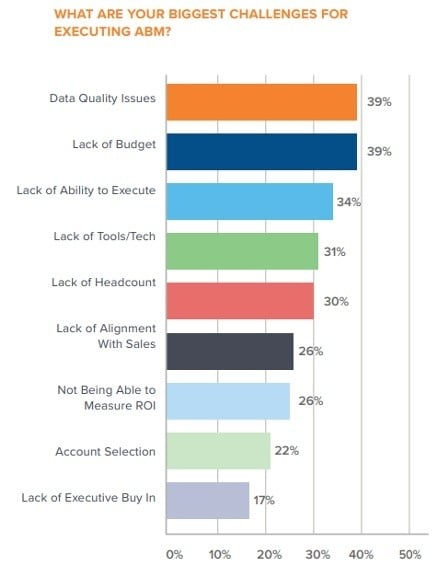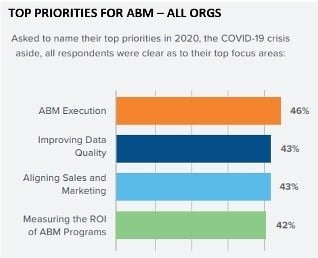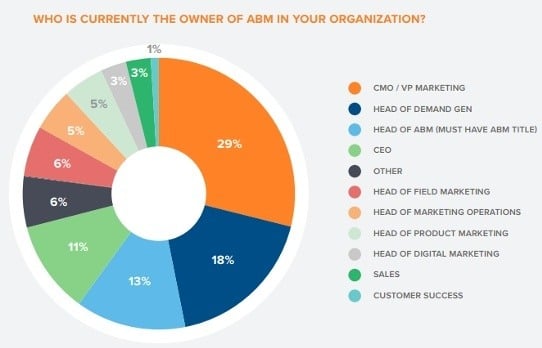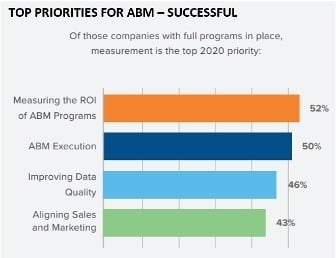
Account-Based Marketing (ABM) is not as simple as it sounds. The concept is simple enough, but executing it requires a lot of foundational building blocks to be in place - which is why ABM initiatives fizzle for four common reasons that you can avoid.
In Demandbase’s 2020 ABM Market Research study, ~900 executives were asked about their top challenges in implementing ABM programs. The top four included Data Quality, Budget, Execution and Technology.
To achieve the many promised benefits of this technology, enterprises should commit to fundamental changes in process, technology, and training.
Let's examine the four greatest reasons why a company may not fully be ready for ABM, based on this survey and my own experiences working with ABM across enterprises.
Need a starting point? Read our Executive's Guide to ABM blog for a strategic overview.
Execution
When asked about top priorities for ABM in 2020, survey responses did not completely align with the challenges described above.
Instead, participating executives showed intention to focus on Execution, Data Quality, Alignment and Measurement in that order:
Why is “Lack of ability to execute” the challenge that rose to top priority? Perhaps because no one is quite sure what good looks like!

ABM is still evolving, and the goalposts keep moving. As I pointed out in a blog titled “How much tech do you REALLY need for ABM?” purchasing a robust software solution does not guarantee that your employees will know what to do with it. Skill-building should come before and during ABM technology, which should not be purchased as a “silver bullet”.
Skill-building should come before and during ABM technology implementation. But what good is an expensive vehicle if no one can drive it? Consider starting with the tools you’ve got, pick some spot solutions as your program matures, and go full-funnel when your MarTech can’t keep up.
Based on “ABM Execution’s” place at the top of the priority list, it seems executives understand that skill-building comes first!
Data Quality
According to Demandbase, “Data quality is holding ABM back from success…Contact and account data quality is an issue that has plagued the success of digital marketing programs since the invention of CRM.”

Many blogs in the market have been dedicated to data quality, but ABM has a few specific problems:
- Poor record-keeping in your CRM system of record. Garbage in, garbage out. Upgrade your key-account data quality, consolidate activity histories from various databases, append and cleanse account data, and hold your staff responsible for accurate, comprehensive, and timely system updates.
- Interoperability between core systems and tools used by Marketing & Sales. Wherever possible, create bi-directional syncs between your CRM, MAP, and all peripheral sales and marketing tools. What good is a great ABM marketing program if the BDRs using Sales Loft cannot incorporate the data into continuous conversations?
- Understanding of baseline performance data before setting lofty ABM goals. Benchmark your performance data. Know your baselines for inbound and outbound marketing tactics. Set modest goals for ABM in year one and two. Do not arbitrarily set a goal of 30% revenue increase without benchmark attribution numbers from last year.
Sales and Marketing Alignment
When Demandbase asked companies to rate their sophistication across the five core parts of an account-based approach, executives gave these responses in order of strongest to weakest:
- Marketing and Sales Alignment
- Establishing a Unified Account Foundation
- ABM Content, Web Personalization & Ads
- Running ABM Plays
- Measurement of ABM
Executive perception of alignment between Marketing and Sales may be wishful thinking.
In our experience, ABM initiatives succeed when driven top-down across the company.
- They fail when Sales thinks ABM is another Marketing trick to make them do more administrative work.
- They also do not succeed when a small marketing team (sometimes just one person) tries to do ABM “on the side.”
ABM must be a commitment on both sides. It requires senior executive commitment and sponsorship across all Marketing and Sales functions. Some best practices include:
- Assign an executive leader/sponsor to the ABM initiative. That sponsor was the CEO, CMO, or Head of Demand Gen in >60% of successful enterprises surveyed. Authority and ability to influence matters.
- Actively work (top-down) to communicate the initiative and reinforce strong cross-functional alignment.
- Invite Mktg/Sales leaders to participate in an ABM Council tasked with implementing a pilot.
- Get agreement with Council on the goals of the ABM initiative and pilot program.
- Schedule regular KPI reporting and progress reviews with ABM Council.
- Create milestones on the roadmap when practices from the ABM pilot can be expanded and converted to standard operating procedures.

Measurement
Along with Data Quality issues, many companies have associated gaps in their Lead Management processes. In particular, lead scoring models are often inadequate to identify Marketing Qualified Accounts accurately.
Account Engagement Scoring is an important practice because it triggers activity more quickly when intent is evident across several key-account contacts.

The ABM Council recommended in the previous section is the appropriate place to review and improve lead management processes, definitions and hand-offs for target accounts. Here are some additional concepts the Council should define and decide together:
- Ideal Customer Profile (ICP)
- Account Data & Hierarchies (Tiers)
- Lead Matching and Contact Linking
- Buying Center/Committee Profiles (BCPs)
- BCP Journey & Campaign Development
- Orchestration – Cross-Team Plays
- Attribution Assessment and ROMI
Participating executives who described having full, mature ABM programs placed “Measurement” as top priority, with Execution moving to second place. Because what gets measured properly gets done.
What does this mean for you?
Account-Based Marketing can absolutely be a game-changing endeavor for a company - but it isn't easy.
Successful ABM requires skill-building, data enhancement, top-down sponsorship, and cross-functional commitment ... and many companies don't have the foundation in place to maximize ABM's true potential.
If you're considering adopting or enhancing ABM within your company, here's some helpful next steps:
- Read how much tech you really need for ABM success
- Learn about our Account-Based Marketing consulting and / or ensure your stack is optimal with our MarTech consulting!



